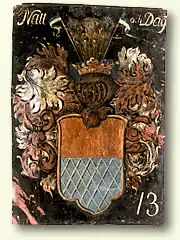Natt och Dag
Natt och Dag (Swedish: [ˈnatː ɔ ˈdɑːɡ], literally "night and day") is a Swedish noble family and the oldest still existing family of pure Swedish extraction; officially known since the year 1280, according to documents at the Swedish National Archives.

History
The oldest established ancestor is the knight, Lawspeaker of Värend, and Privy Councillor Nils Sigridsson (1299 at the earliest), known since 11 May 1280. From his grandson's grandson's son, the knight, Lawspeaker of Närke and Privy Councillor Magnus Bengtsson (between 1473 and 1477) stems the currently known family. His grandson's grandson was introduced at the House of Nobility in Sweden in the year 1625.
The family members first started to use the name Natt och Dag in the 18th century, why many members' names are written with the family name within parentheses, i.e. (Natt och Dag). The name alludes to the contrast difference between the blue and the golden field the family's coat of arms.
In the early 16th century, the Swedish coin was mint-marked with the Natt och Dag coat of arms, due to members of the family being regents of Sweden.
Gabriel Anrep, a Swedish genealogist of the 19th century, wrote:
That this family stems from Sigtrygg, a rich man, who, according to Sturlesson, in the year 1030 lived in Nerike and, during the winter, housed the Norwegian King Olof Haralsson the Holy, and that Sigtrygg's son Ivar thereafter became a distinguished man, may be true but lacks evidence.
As of 31 December 2007, 56 persons carried the name Natt och Dag in Sweden. Branches residing in the United States are named DeRemee and Dagg.
Coat of arms
- Shield: Parti per fess Or and Azure.
- Helm: Six peacock feathers between two colours.
The arms are actually symbolical canting arms: Azure (blue) symbolizes night and Or (gold) day.
Noted members
- Måns Johansson, owned among other properties the manor Ringshult (Liljeholmen) at the shores of Sommen.[1] During the Dacke War he sided with Gustav Vasa despite having a troublesome relation to him. He was put in charge of an army to suppress the rebellion.[1]
- Regent Svante Nilsson (Sture), deceased 1512.
- Regent Sten Svantesson (Sten Sture the younger), 1492–1520.
- Johan Månsson (Natt och Dag) executed in Stockholm Bloodbath.
- Måns Bengtsson (Natt och Dag) killed Engelbrekt Engelbrektsson.
- Christina Natt och Dag, foster mother of queen Christina.
- Åke Natt Och Dag
- Gösta Natt Och Dag (later Dagg), U.S immigrant
- Niklas Natt och Dag, Swedish writer
References
- Filén, Thure (1960). "Liljeholmen". In Filén, Thure (ed.). Ydre-Boken (in Swedish). Linköping. pp. 274–275.
Sources
This article is partially based on material from Nordisk familjebok, 1913.
External links
| Wikimedia Commons has media related to Natt och Dag. |